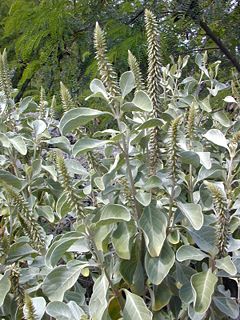Amaranthaceae
| Amaranthaceae | ||||||||||
|---|---|---|---|---|---|---|---|---|---|---|
 Achyranthes splendens var. rotundata
|
||||||||||
| Scientific classification | ||||||||||
|
||||||||||
| Type genus | ||||||||||
| Amaranthus L. |
||||||||||
| Subfamilies | ||||||||||
|
Amaranthoideae |
The flowering plant family Amaranthaceae, the Amaranth family, contains about 160 genera and 2,400 species. Most of these species are herbs or subshrubs; very few are trees or climbers.
This is a widespread and cosmopolitan family found mostly in subtropical and tropical regions, although many species belong in cool temperate regions.
In the APG II system, of 2003 (unchanged from the APG system, of 1998), the family is placed in the order Caryophyllales. It includes the plants formerly treated as the family Chenopodiaceae. The monophyly of this new, broadly defined Amaranthaceae has been strongly supported by both morphological and phylogenetic analyses. [1] Well-known chenopodioid species include beet, goosefoot, quinoa, and spinach. The main differences between Amaranthaceae and Chenopodiaceae are membraneous petals and stamens often united in a ring structure.
Prior to the incorporation of Chenopodiaceae, the Amaranthaceae (in their narrow circumscription) contained only about 65 genera and 900 species. Most of these species occur in tropical Africa and North America. Some species are considered weeds, but a number of others are popular garden ornamental plants, especially species from Alternanthera, Amaranthus, Celosia, and Iresine. Notable members include amaranth and tumbleweeds. Many of the species are halophytes, growing in salty soils.
The leaves are simple, opposite or alternate, their margins entire or coarsely toothed, and without stipules. In most cases, there are neither basal or terminal aggregations of leaves.
The flowers are solitary or aggregated in cymes, spikes, or panicles and typically perfect (bisexual) and actinomorphic. A few species have unisexual flowers. The bracteate flowers are regular with 4-5 petals, often joined. There are 1-5 stamens. The hypogynous ovary has 3-5 joined sepals.
The fruit can be an utricle, nut, or circumscissile capsule, rarely a berry.
Notes
- ↑ Judd et al (2008). Plant Systematics: A Phylogenetic Approach, Third Edition. Sinauer Associates, Inc. Sunderland, MA
References
- Kai Müller and Thomas Borsch - Phylogenetics of Amaranthaceae based on matK/trnK sequence data - Evidence from parsimony, likelihood and Bayesian analyses. Annals of the Missouri Botanical Garden 92 (1): 66–102.